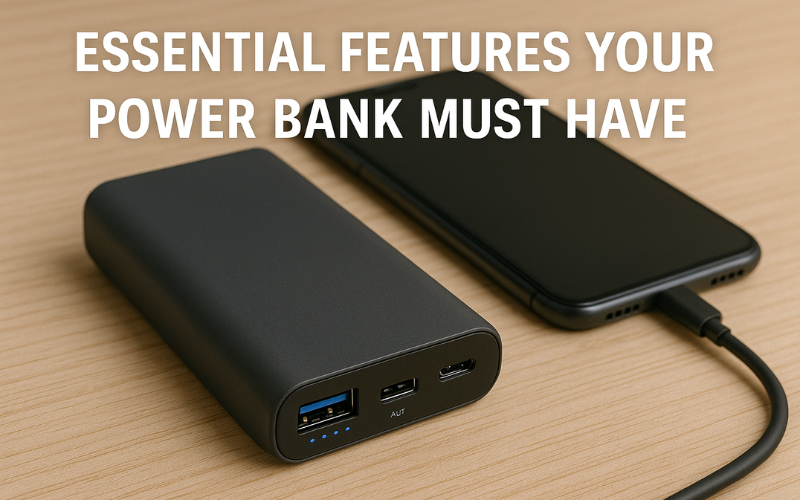Power Bank Safety Tips: Essential Guide for Dubai Buyers
In today’s fast-paced lifestyle, a power bank has become more than just a convenience, it’s a necessity. Whether you’re commuting, traveling, or just busy with work, a portable charger ensures you stay connected.
But while buying a power bank in Dubai, safety must come first.Here’s everything you need to know before making your purchase.
Why Power Bank Safety Matters
Power banks store significant amounts of energy. If poorly manufactured or mishandled, they can overheat, catch fire, or even explode.
Dubai’s hot climate only adds to the risks. Choosing a reliable, safe device can protect your health, devices, and peace of mind.
Choose Certified Products Only
Always look for certifications that guarantee the power bank has passed safety standards. Important certifications to check include:
- CE (Conformité Européenne): Ensures it meets EU safety standards.
- FCC (Federal Communications Commission): Meets US electronic safety guidelines.
- RoHS (Restriction of Hazardous Substances): Certifies no harmful materials.
Buying from trusted retailers in Dubai malls or reputable online stores significantly reduces your chances of ending up with a low-quality, unsafe device.
Understand Battery Capacity and Real Output
Bigger numbers aren’t always better. Some manufacturers list “theoretical” capacity without clarifying real-world output. A good power bank clearly mentions:
| Label | What It Means |
| mAh (Milliampere-Hour) | The total charge the battery holds. |
| Actual Output Capacity | The usable power after internal losses. |
For example, a 10,000mAh bank usually offers about 6,500–7,000mAh of real output. Always check detailed specs before buying.
Pick the Right Battery Type
Not all batteries are made the same. You’ll typically find two types:
- Lithium-Ion (Li-ion): Lighter, cheaper, but less durable.
- Lithium-Polymer (Li-Po): More stable, safer, and longer-lasting.

Lithium-Polymer batteries are better suited for Dubai’s heat, providing greater protection against swelling or leakage.
Pay Attention to the Build Quality
A solid, well-constructed power bank feels sturdy and has proper heat dissipation mechanisms. Signs of good build quality:
- Rounded edges without sharp seams.
- Strong casing made of ABS plastic or aluminum alloy.
- No rattling sounds when shaken.
Tip: Avoid flashy designs with thin plastic bodies, as they often compromise durability and safety.
Essential Features Your Power Bank Must Have
Some features aren’t just “nice to have” they’re critical for safety:
| Safety Feature | Importance |
| Overcharge Protection | Stops charging once full to prevent overheating. |
| Short-Circuit Protection | Cuts off current if a fault is detected. |
| Temperature Control | Prevents internal overheating. |
| Automatic Cut-off | Shuts down in case of irregular power input/output. |

When shopping in Dubai, always ask the salesperson or check the manual for these features.
Watch Out for Fake or Counterfeit Power Banks
Dubai’s vast electronics markets sometimes see an influx of counterfeit brands. Here’s how to spot fakes:
- Too-good-to-be-true prices: 20,000mAh for AED 50? Walk away.
- No brand labeling or misspelled names: An obvious red flag.
- Low weight compared to advertised capacity: Heavier units generally indicate a larger, real battery inside.
Always verify the warranty and ask for an invoice. Trusted brands like Anker, Xiaomi, Samsung, RavPower, and Baseus are widely available and highly reliable.
Handling and Storage Tips for Maximum Safety
Once you buy a quality power bank, proper handling ensures it remains safe to use. Follow these guidelines:
- Avoid overcharging: Unplug once your device is full.
- Keep away from direct sunlight: Especially inside parked cars during Dubai summers.
- Use original cables: Always use compatible, branded cables to charge your power bank.
- Store in cool, dry places: Humidity and heat are your battery’s enemies.
Warning: Never use a bloated or damaged power bank. Dispose of it safely at Dubai Municipality-approved recycling points.
When to Replace Your Power Bank
Even the best power banks have a limited lifespan. Signs that you need a replacement include:
- Swelling or bulging
- Unusual heating during use
- Very slow or no charging
- Strange smells from the device
Most quality power banks last between 300 to 500 charge cycles. If your unit shows any of the above signs, stop using it immediately and invest in a new one.
Final Thoughts
Choosing the right power bank isn’t just about price or capacity. It’s about protecting your devices and yourself. As a Dubai shopper, being mindful of certifications, build quality, proper features, and correct handling can make all the difference.
Stay safe, stay powered!
Leave a reply